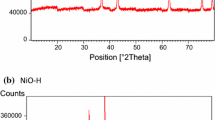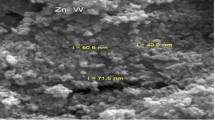Abstract
Nanoparticles (NPs) modified with proper compounds are now gaining much attention for their function as new adsorbents for environmental remediation. The main objective of this study is to determine the effectiveness of modified nanoparticles (MNPs) as sorbents in removing Cd+2, Cu+2, and Ni+2 from single and competitive solutions by TiO2 NPs modified with humic acid (Ti–H), extractant of Walnut shell (Ti–W), and 1, 5 diphenyl-Carbazon (Ti–C). MNPs were characterized by XRD, FT-IR, and SEM–EDX analyzer. The MNPs were spherical in shape. The mean diameter of MNPs was determined to be 64.7 nm. The sorption of Cd+2 and Cu+2 on MNPs fitted better in Langmuir model than Freundlich model. But Ni+2 sorption better fitted in Freundlich model. Kinetics of adsorption follow pseudo-second order kinetic model than pseudo-first-order kinetic model. The adsorption maximum was observed at pH 7. Adsorption capacities of MNPs were obtained from Langmuir model and final point of isotherm. Comparison with published adsorption capacities for other adsorbents indicated that Ti–W and Ti–C had potential as proper adsorbents for the removal of Cd+2 and Cu+2 from single and competitive aqueous solution and Ti–H was a good candidate for Ni+2 removal from single and competitive solutions.







Similar content being viewed by others
References
Abbasizadeh S, Keshtkar AR, Mousavian MA (2014) Sorption of heavy metal ions from aqueous solution by a novel cast PVA/TiO2 nanohybrid adsorbent functionalized with amine groups. J Ind Eng Chem 20:1656–1664
Alvarez-Ayuso E, Garcı´a-Sa´nchez A, Querol X (2003) Purification of metal electroplating waste waters using zeolites. Water Res 37:4855–4862
Azizian S (2004) Kinetic models of sorption: a theoretical analysis. J Colloid Interface Sci 276:47–52
Baraton MI, Merhari L (2004) Surface chemistry of TiO2 nanoparticles: influence on electrical and gas sensing properties. J Eur Ceram Soc 24:399–1404
Boparai HK, Joseph M, O’Carroll DM (2013) Cadmium (Cd2+) removal by nano zero-valent iron: surface analysis, effects of solution chemistry and surface complexation modeling. Environ Sci Pollut Res 20:6210–6221
Chappell MA (2009) Nanomaterials: risks and benefits, I. Linkov and J. Steevens (eds.), 111 ©Springer Science + Business Media B.V
Chen Q, Yin D, Zhu S, Hu X (2012) Adsorption of Cadmium (II) on humic acid coated Titanium dioxide. J Colloid Interface Sci 367:241–248
Chen J, Hao Y, Chen M (2014) Rapid and efficient removal of Ni2+ from aqueous solution by the one-pot synthesized EDTA-modified magnetic nanoparticles. Environ Sci Pollut Res 21:1671–1679
Engates KE, Shipley HJ (2011) Adsorption of Pb2+, Cd2+, Cu2+, Zn2+, and Ni2+ to Titanium dioxide nanoparticles: effect of particles size, solid concentration, and exhaustion. Environ Sci Pollut Res 18:386–395
Foo LPY, Tee CZ, Raimy NR, Hassell DG, Lee LY (2012) Potential Malaysia agricultural waste materials for the biosorption of cadmium (II) from aqueous solution. Clean Technol Environ Policy 14:273–280
Guo XY, Zhang SZ, Shan XQ (2008) Adsorption of metal ions on lignin. J Hazard Mater 15:134–142
Gupta RK, Nayak A (2012) Cadmium Removal and recovery from aqueous solution by novel adsorbents prepared from orange peel and Fe2O3 nanoparticles. Chem Eng J 180:81–90
Hammaini A, Gonzalez F, Ballester A, Bla´ zquez ML, Mun˜ oz JA (2007) Biosorption of heavy metals by activated sludge and their desorption characteristics. J Environ Manag 84:419–426
Hua M, Zhang S, Pan B, Zhang W, Lv L, Zhang Q (2012) Heavy metal removal from water/wastewater by nanosized metal oxides: a review. J Hazard Mater 211–212:317–331
Jalbani N, Soylak M (2014) Ligandless surfactant mediated solid phase extraction combined with Fe3O4 nano-particle for the preconcentration and determination of cadmium and lead in water and soil samples followed by flame atomic absorption spectrometry: multivariate strategy. Ecotoxicol Environ Saf 102:174–178
Jaman H, Chakraborty D (2009) a study of the thermodynamics and kinetics of Copper adsorption using chemically modified rice husk. Clean Technol Environ Policy 37:704–711
Kim JW, Sohn MH, Kim DS, Sohn SM, Kwon YS (2001) Production of granular activated carbon from waste walnnt shell and its adsorption characteristics of Cu2+ ion. J Hazard Mater 85(3):301–315
Lai YL, Thirumavalavan M, Lee JF (2010) Effective adsorption of heavy metal ions (Cu2+, Pb2+, and Zn2+) from aqueous solution by immobilization of adsorbents on Ca-alginate beads. Toxicol Environ Chem 92:697–705
Lee YC, Yang JW (2012) Self-assembled flower-like TiO2 on exfoliated graphite oxide for heavy metal removal. J Ind Eng Chem 18:1178–1185
Liu W, Sun W, Han Y, Ahmad Muhammad, Ni Jinren (2014) Adsorption of Cu(II) and Cd(II) on titanate nanomaterials synthesizedvia hydrothermal method under different NaOH concentrations: role of sodium content. Colloid Surf A 452:138–147
Mahdavi S, Jalali M, Afkhami A (2012) Removal of heavy metals from aqueous solutions using Fe3O4, ZnO, and CuO nanoparticles. J Nanopart Res 14:1–18
Mahdavi S, Jalali M, Afkhami A (2013) Heavy metals removal from aqueous solutions using TiO2, MgO, and Al2O3 nanoparticles. Chem Eng Commun 200:448–470
Mahdavi S, Jalali M, Afkhami A (2015) Heavy metals removal from aqueous solutions by Al2O3 nanoparticles modified with natural and chemical modifiers. Clean Technol Environ Policy 17:85–102
Malkoc E, Nuhoglu Y (2005) Ni (II) removal from aqueous solution using tea factory waste. J Hazard Mater 127:120–128
Malkoc E, Nuhoglu Y (2006) Ni (II) removal from aqueous solutions using cone biomass of Thuja orientalis. J Hazard Mater 137:899–908
Meyi HY, Man C, Bo HZ (2010) Effective removal of Cu (II) ions from aqueous solution by amino-functionalized magnetic nanoparticles. J Hazard Mater 184:392–399
Mosh TB, Dror I, Berkowitz B (2010) Transport of metal oxide nanoparticles in saturated porous media. Chemosphere 81:387–393
Pehlivan E, Cetin S, Yank BH (2006) Equilibrium studies for the sorption of zinc and copper from aqueous solutions using sugar beet pulp and fly ash. J Hazard Mater B135:193–199
Peng L, Qin P, Lei M, Zeng Q, Song H, Yang J, Shao J, Liao B, Gu J (2012) Modifying Fe3O4 nanoparticles with humic acid for removal of Rhodamine B in water. J Hazard Mater 209–2010:193–198
PhuengPrasop T, Sittiwong J, Unob F (2011) Removal of heavy metals ions by iron oxide coated sewage sludge. J Hazard Mater 186:502–507
Pourreza N, Rastegarzadeh S, Larki A (2014) Nano-TiO2 modified with 2-mercaptobenzimidazole as an efficient adsorbent for removal of Ag(I) from aqueous solutions. J Ind Eng Chem 20:127–132
Shahbazi A, Younesi H, Badiei A (2014) Functionalized nanostructured silica by tetra dentate-amine chelating ligand as efficient heavy metals adsorbent : applications to industrial effluent treatment. Korean J Chem Eng 31:1598–1607
Sharma YC, Srivastava VU, Padhyay SN, Weng CH (2008) Alumina nanoparticles for the removal of Ni (II) from aqueous solution. Ind Eng Chem Res 47:8095–8100
Sica M, Duta A, Teodosiu C, Draghici C (2014) Thermodynamic and kinetic study on ammonium removal from a synthetic water solution using ion exchange resin. Clean Techn Environ Policy 16:351–359
Tan Y, Chen M, Hao Y (2012) High efficient removal of Pb(II) by amino-functionalized Fe3O4 magnetic nano-particles. Chem Eng J 191:104–111
Ucar S, Erdem M, Tay T, Karago¨z S (2015) Removal of lead (II) and nickel (II) ions from aqueous solution using activated carbon prepared from rapeseed oil cake by Na2CO3 activation. Clean Techn Environ Policy 17:747–756
Unuabonah EI, Adebowale KO, Olu-Owolabi BI, Yang LZ, Kong LX (2008) Adsorption of Pb(II) and Cd(II) from aqueous solutions onto sodium tetraborate-modified kaolinite clay: equilibrium and thermodynamic studies. Hydrometallurgy 93:1–9
Vaclavikova M, Gallios PG, Slavomir H, Jakabsky S (2008) Removal of arsenic from water streams: an overview of available techniques. Clean Technol Environ Policy 10:89–95
Visa M, Duta A (2013) TiO2/fly ash novel substrate for simultaneous removal of heavy metals and surfactants. Chem Eng J 223:860–868
Xie X, Gao L (2009) Effect of crystal structure on adsorption behaviors of nanosized TiO2 for heavy-metal cations. Curr Appl Phys 9:S185–S188
Xu X, Cao X, Zhao L, Wang H, Yu H, Gao B (2013) Removal of Cu, Zn, and Cd from aqueous solutions by the dairy manure-derived biochar. Environ Sci Pollut Res 20:358–368
Yang K, Lin D, Xing B (2009) Interactions of humic acid with nanosized inorganic oxides. Langmuir 25:3571–3576
Yang J, Liang Zhou L, Zhao L, Zhang H, Yin J, Wei G, Qian K, Wangb Y, Yu C (2011) A designed nanoporous material for phosphate removal with high efficiency. J Mater Chem 21:2489–2494
Yuwei C, Jialong W (2011) Preparation and characterization of magnetic chitosan nanoparticles and it, s application for Cu(II) removal. Chem Eng J 168:286–292
Zamani AA, Shokri R, Yaftian MR, Parizanganeh AA (2013) Adsorption of lead, zinc and cadmium ions from contaminated water on to Peganum harmala seeds as biosorbent. Int J Environ Sci Technol 10:93–102
Zha R, Nadimicherla R, Guo X (2014) Cadmium removal in waste water by nanostructured TiO2 particles. J Mater Chem A2:13932–13941
Zhang L, Na Liu, Yang L, Lin Q (2009) Sorption behavior of nano-TiO2 for the removal of selenium ions from aqueous solution. J Hazard Mater 170:1197–1203
Author information
Authors and Affiliations
Corresponding author
Rights and permissions
About this article
Cite this article
Mahdavi, S. Nano-TiO2 modified with natural and chemical compounds as efficient adsorbents for the removal of Cd+2, Cu+2, and Ni+2 from water. Clean Techn Environ Policy 18, 81–94 (2016). https://doi.org/10.1007/s10098-015-0993-y
Received:
Accepted:
Published:
Issue Date:
DOI: https://doi.org/10.1007/s10098-015-0993-y




